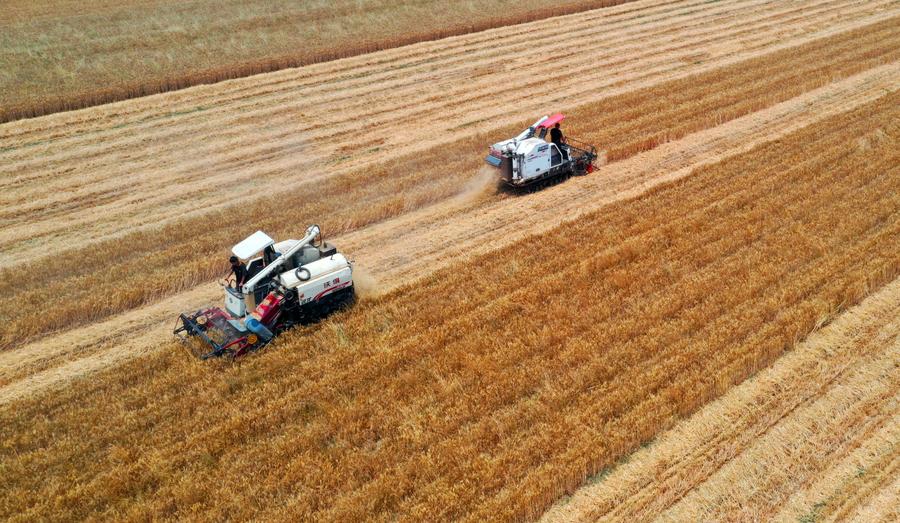
A drone photo shows harvesters in a wheat field in Liuzhuang Township of Queshan County, central China's Henan Province, May 27, 2024. [Photo/Xinhua]
The Ministry of Natural Resources has called for strict protection of arable land while balancing the interests of farmers and rural industry development, ahead of the country's annual National Land Day, which falls on Wednesday this year.
Farmland is considered critical to ensuring food security for China's population of 1.4 billion. The country has drawn a red line of 120 million hectares of farmland that must be preserved exclusively for agricultural use, not for construction or other non-agricultural purposes.
At a news conference on Friday, the ministry stressed that the red line must not be breached and that high-quality farmland should be prioritized for grain production.
In some areas, farmland has been used to plant trees, fruits and tea as part of poverty alleviation and rural vitalization efforts. Officials warned that a rushed conversion of these lands back to traditional farmland for crops such as grains and vegetables could threaten income-generating industries, potentially increasing the risk of a return to poverty.
To address this, the ministry is urging local governments to set transition periods based on real conditions and to follow a phased approach of "identifying, restoring and swapping" land, said He Yong, director of the ministry's department of farmland protection and supervision.
"Identifying" refers to accurately locating and strictly protecting land that meets arable land standards, particularly plots with fertile topsoil. The "restoring" phase involves gradually bringing large, contiguous plots with good irrigation conditions back into grain production, considering factors such as farmers' preferences, crop cycles and local industry development.
"Swapping" relates to removing land deemed unsuitable for restoration from protected status and replacing it with more suitable plots for farmland designation, He explained.
Zhao Pan, an official with the natural resources bureau in Dezhou, Shandong province, said the transition policy has brought benefits to local land management.
"It clarifies land categorization, protects local interests and reduces grassroots workload. Gradual restoration aligns with natural laws and helps maintain a dynamic balance in the total amount of farmland," Zhao said.
Replacing land unsuitable for grain production also optimizes land use and improves overall efficiency, Zhao said. In Xiajin county of Dezhou, where desertification and low yields hinder traditional farming, some areas have been transformed into mulberry-planting zones. The region's mulberry has been awarded a national agricultural product geographical indication.
In addition, consolidating fragmented plots into larger fields has improved the feasibility of mechanized farming and large-scale operations, cutting production costs and enhancing grain output, Zhao added.
To further optimize permanent basic farmland, the Ministry of Natural Resources, in cooperation with the Ministry of Agriculture and Rural Affairs, is drafting new guidelines for managing and protecting the farmland red line.
The goal is to cluster farmland into contiguous zones and raise the share of high-quality plots while maintaining strict red-line protections, according to the ministry.


 Share:
Share: 




 京公網(wǎng)安備 11010802027341號(hào)
京公網(wǎng)安備 11010802027341號(hào) 主站蜘蛛池模板:
治多县|
佛山市|
张家口市|
广安市|
巨鹿县|
庆元县|
滁州市|
大兴区|
凤山市|
溆浦县|
札达县|
靖安县|
永城市|
冀州市|
海安县|
余庆县|
本溪|
禄丰县|
博客|
隆化县|
岚皋县|
若尔盖县|
华宁县|
保靖县|
克什克腾旗|
梧州市|
吉安县|
大厂|
汪清县|
平原县|
商南县|
卢龙县|
达拉特旗|
博罗县|
乡宁县|
罗源县|
宁城县|
二连浩特市|
杭州市|
赤城县|
思茅市|
主站蜘蛛池模板:
治多县|
佛山市|
张家口市|
广安市|
巨鹿县|
庆元县|
滁州市|
大兴区|
凤山市|
溆浦县|
札达县|
靖安县|
永城市|
冀州市|
海安县|
余庆县|
本溪|
禄丰县|
博客|
隆化县|
岚皋县|
若尔盖县|
华宁县|
保靖县|
克什克腾旗|
梧州市|
吉安县|
大厂|
汪清县|
平原县|
商南县|
卢龙县|
达拉特旗|
博罗县|
乡宁县|
罗源县|
宁城县|
二连浩特市|
杭州市|
赤城县|
思茅市|